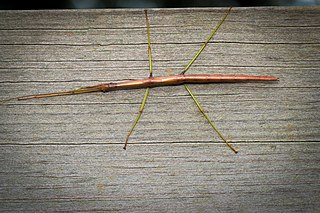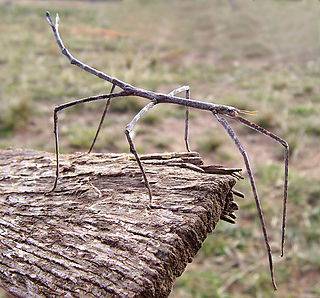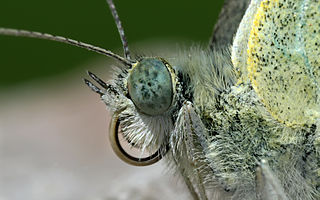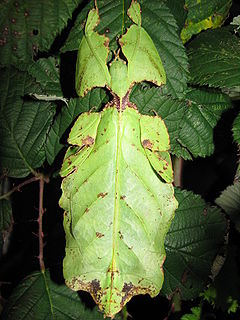
The Phasmatodea are an order of insects whose members are variously known as stick insects, stick-bugs, walking sticks, stick animals, or bug sticks. They are generally referred to as phasmatodeans, phasmids, or ghost insects. Phasmids in the family Phylliidae are called leaf insects, leaf-bugs, walking leaves, or bug leaves. The group's name is derived from the Ancient Greek φάσμα phasma, meaning an apparition or phantom, referring to their resemblance to vegetation while in fact being animals. Their natural camouflage makes them difficult for predators to detect; still, many species have one of several secondary lines of defence in the form of startle displays, spines or toxic secretions. Stick insects from the genera Phryganistria, Ctenomorpha, and Phobaeticus includes the world's longest insects.

The blue-tailed damselfly or common bluetail is a damselfly, belonging to the family Coenagrionidae.

The family Phylliidae contains the extant true leaf insects or walking leaves, which include some of the most remarkably camouflaged leaf mimics (mimesis) in the entire animal kingdom. They occur from South Asia through Southeast Asia to Australia. Earlier sources treat Phylliidae as a much larger taxon, containing genera in what are presently considered to be several different families.

Hymenopus coronatus is a mantis from the tropical forests of Southeast Asia. It is known by various common names including walking flower mantis and (pink) orchid mantis. It is one of several species known as flower mantises from their resemblance and behaviour. They are known to grab their prey with blinding speed.

Heteropteryx is a monotypic genus of stick insects containing Heteropteryx dilatata as the only described species. and gives its name to the family of the Heteropterygidae. Their only species may be known as jungle nymph, Malaysian stick insect, Malaysian wood nymph, Malayan jungle nymph, or Malayan wood nymph and because of their size it is commonly kept in zoological institutions and private terrariums of insect lovers. It originates in Malay Archipelago, more precisely on the Malay Peninsula and Borneo and is nocturnal.

The common walkingstick or northern walkingstick is a species of phasmid or stick insect found across North America. The average length of this species is 75mm (3 in) for males and 95mm (3.7 in) for females.

Phyllium is the largest and most widespread genus of leaf insects in the family Phylliidae (Phasmatodea). They can be found in Sundaland, Philippine Islands, Wallacea, Australasia.

Eurycnema goliath, commonly known as the goliath stick insect, or the regal stick insect, is a large species of stick insect in the family Phasmatidae, endemic to Australia and considered one of the largest species of stick insects in the country. The species has the Phasmid Study Group number PSG14.

Ctenomorpha marginipennis, the margin-winged stick insect, is a species of stick insect endemic to southern Australia. The species was first described by George Robert Gray in 1833.

The external morphology of Lepidoptera is the physiological structure of the bodies of insects belonging to the order Lepidoptera, also known as butterflies and moths. Lepidoptera are distinguished from other orders by the presence of scales on the external parts of the body and appendages, especially the wings. Butterflies and moths vary in size from microlepidoptera only a few millimetres long, to a wingspan of many inches such as the Atlas moth. Comprising over 160,000 described species, the Lepidoptera possess variations of the basic body structure which has evolved to gain advantages in adaptation and distribution.

Empis tessellata is a species of dance fly, in the fly family Empididae. It is included in the subgenus Euempis.

Pulchriphyllium giganteum, commonly known as the Giant Malaysian Leaf insect, is a species of leaf insects described from Malaysia by Hausleithner in 1984 and placed in the genus Pulchriphyllium since 2021. Pulchriphyllium giganteum is the largest species belonging to the genus Pulchriphyllium reaching 105 mm in size. They are found most abundantly in the west Malaysian tropics. The females typically have large elytra that lie edge to edge on the abdomen and tend to lack hind wings making them usually flightless. Males have small elytra and sometimes transparent non-leaflike functional hind wings. Pulchriphyllium giganteum found in the wild tend to be mostly females and the first male of this species was not found until 1994. In captivity, the species has primarily been observed to reproduce through parthenogenesis meaning the females are asexual. The primary reproductive pattern in the wild is unknown. Eggs tend to be brown or black and glossy and resemble the look of seeds. They hatch around 6 months after breeding. Newly hatched young nymphs tend to be wingless and brown or reddish in color. They develop their green color after feeding on leaves. Both the adult and larval stages are phytophagous meaning they feed on plants. The main plant food sources for this species are oak and bramble tree leaves.

Pulchriphyllium bioculatum, or Gray's leaf insect, is a leaf insect of the family Phylliidae native to tropical Asia as well as Madagascar, Mauritius and the Seychelles. It was first described by George Robert Gray in 1832, which was his first phasmid he discovered. Leaf insects have extremely flattened, irregularly shaped bodies, wings, and legs. They are usually about 5–10 cm long. They are called leaf insects because their large, leathery forewings have veins that look similar to the veins on the particular type of leaves they inhabit. Its scientific name bioculatum means "two-eyed" and refers to the two dots located on the abdomen just in this species.
Odonata are insects with an incomplete metamorphosis (hemimetabolous). The aquatic larva or nymph hatches from an egg, and develops through eight to seventeen instars before leaving the water and emerging as the winged adult or imago.

Phyllium hausleithneri, ore Hausleithner's stick insect, is a species of phasmid or leaf insect of the genus Phyllium. It is found in peninsular Malaysia, and Sri Lanka.
Pseudomicrophyllium geryon is a species of phasmid or leaf insect. It is found in the Philippines, Java (Indonesia), and Sri Lanka.
Callipappus australis, commonly known as the bird of paradise fly, is a species of scale insect in the family Callipappidae. It is native to Australia where it occurs in Queensland and New South Wales.

Dares philippinensis is a species of stick insects. This species is not native to Borneo like most other members of the genus Dares, but to the Philippine island Palawan.

Haaniella dehaanii is a stick insect species. It is a typical representative of the subfamily Heteropteryginae. The occasionally used common name De Haan's haaniella refers to the species name.

Phyllium philippinicum is a species of leaf insect in the family Phylliidae. It is endemic to the Philippines.

















